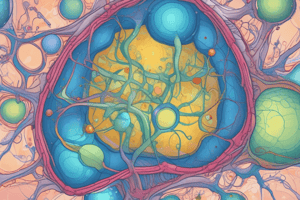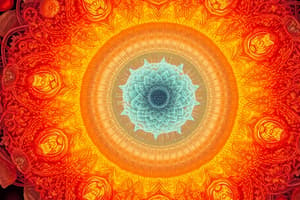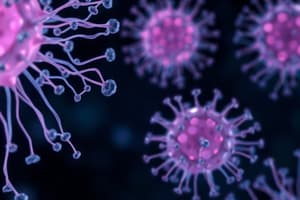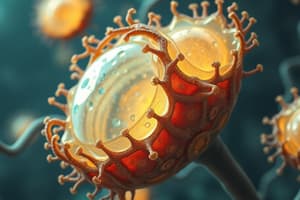Podcast
Questions and Answers
What role do myosin motor proteins play in the cell?
What role do myosin motor proteins play in the cell?
- They regulate microtubule stability.
- They synthesize Okazaki fragments.
- They degrade RNA and DNA.
- They transport vesicles along actin filaments. (correct)
What is the primary function of Bcl-2 in a cell?
What is the primary function of Bcl-2 in a cell?
- To facilitate RNA degradation.
- To promote apoptosis.
- To act as a DNA ligase.
- To inhibit apoptosis. (correct)
How are Okazaki fragments removed during DNA replication?
How are Okazaki fragments removed during DNA replication?
- By RNA polymerase.
- By helicase.
- By nucleases.
- By DNA ligase. (correct)
Which statement about microtubules is true?
Which statement about microtubules is true?
What is the correct outcome for neurons competing for survival factors?
What is the correct outcome for neurons competing for survival factors?
What is the function of calmodulin in cells?
What is the function of calmodulin in cells?
What false statement is associated with nucleosome core particles?
What false statement is associated with nucleosome core particles?
What mechanism allows glycolipids to move between different membrane compartments?
What mechanism allows glycolipids to move between different membrane compartments?
What is a key advantage of using stem cells in drug testing and development?
What is a key advantage of using stem cells in drug testing and development?
Which type of stem cells is derived from embryos at the blastocyst stage?
Which type of stem cells is derived from embryos at the blastocyst stage?
What is a significant concern associated with the use of embryonic stem cells?
What is a significant concern associated with the use of embryonic stem cells?
Which of the following is a characteristic of adult stem cells?
Which of the following is a characteristic of adult stem cells?
Which of the following indicates a morphological change due to pro-apoptotic factors?
Which of the following indicates a morphological change due to pro-apoptotic factors?
What is calmodulin primarily associated with in cellular processes?
What is calmodulin primarily associated with in cellular processes?
What is essential for successful cell culturing?
What is essential for successful cell culturing?
What represents the directed movement of cells towards a concentration gradient?
What represents the directed movement of cells towards a concentration gradient?
Which of the following is a function of peroxisomes?
Which of the following is a function of peroxisomes?
How did peroxisomes likely evolve according to the endosymbiotic theory?
How did peroxisomes likely evolve according to the endosymbiotic theory?
Which of the following statements is true regarding G proteins?
Which of the following statements is true regarding G proteins?
What distinguishes symporters from antiporters?
What distinguishes symporters from antiporters?
Which type of transport mechanism allows solutes to cross a membrane more quickly?
Which type of transport mechanism allows solutes to cross a membrane more quickly?
What happens in the rough endoplasmic reticulum (rER)?
What happens in the rough endoplasmic reticulum (rER)?
What role does ATP play in the function of transporters?
What role does ATP play in the function of transporters?
What is one of the primary functions of the smooth endoplasmic reticulum (sER)?
What is one of the primary functions of the smooth endoplasmic reticulum (sER)?
Which is NOT one of the criteria of terrestrial life?
Which is NOT one of the criteria of terrestrial life?
Which statement is true regarding the RNA world theory?
Which statement is true regarding the RNA world theory?
What role does the nuclear lamina play in the nucleus?
What role does the nuclear lamina play in the nucleus?
Why is stem cell research considered crucial?
Why is stem cell research considered crucial?
What process is involved in the N-glycosylation of proteins?
What process is involved in the N-glycosylation of proteins?
What is a significant role of the rough endoplasmic reticulum?
What is a significant role of the rough endoplasmic reticulum?
Which characteristic is NOT associated with the functionality of the liver's rough endoplasmic reticulum?
Which characteristic is NOT associated with the functionality of the liver's rough endoplasmic reticulum?
Which cellular movement is characterized by the cell moving in response to necrotic factors released by injured cells?
Which cellular movement is characterized by the cell moving in response to necrotic factors released by injured cells?
What is the primary effect of colchicine on microtubules?
What is the primary effect of colchicine on microtubules?
Which statement correctly describes the role of GTP in microtubule dynamics?
Which statement correctly describes the role of GTP in microtubule dynamics?
Which of the following accurately describes kinases in cellular processes?
Which of the following accurately describes kinases in cellular processes?
What is the relationship between microtubules and DNA replication?
What is the relationship between microtubules and DNA replication?
What is the primary role of the cytoskeleton?
What is the primary role of the cytoskeleton?
Which characteristic is unique to mitochondria compared to other organelles?
Which characteristic is unique to mitochondria compared to other organelles?
What distinguishes intermediate filaments from other types of cytoskeletal structures?
What distinguishes intermediate filaments from other types of cytoskeletal structures?
Microtubules are primarily composed of which proteins?
Microtubules are primarily composed of which proteins?
What is a shared function of microfilaments, microtubules, and intermediate filaments in the cell?
What is a shared function of microfilaments, microtubules, and intermediate filaments in the cell?
Flashcards
Myosin and Actin in Vesicle Transport
Myosin and Actin in Vesicle Transport
Myosin motor proteins move vesicles along actin filaments, enabling intracellular transport and cellular organization.
Bcl-2 and Apoptosis
Bcl-2 and Apoptosis
Bcl-2 is an anti-apoptotic protein that blocks the cell's programmed death pathway.
Okazaki Fragments and DNA Ligase
Okazaki Fragments and DNA Ligase
Okazaki fragments are short DNA segments synthesized on the lagging strand during replication. DNA ligase joins these fragments, not nucleases.
Microtubules and DNA Replication
Microtubules and DNA Replication
Signup and view all the flashcards
Neuronal Survival and Apoptosis
Neuronal Survival and Apoptosis
Signup and view all the flashcards
Calmodulin and Calcium Regulation
Calmodulin and Calcium Regulation
Signup and view all the flashcards
Nucleosome Core Size and Structure
Nucleosome Core Size and Structure
Signup and view all the flashcards
Glycolipid Movement in Membranes
Glycolipid Movement in Membranes
Signup and view all the flashcards
What are peroxisomes?
What are peroxisomes?
Signup and view all the flashcards
What does catalase do?
What does catalase do?
Signup and view all the flashcards
What are very-long-chain fatty acids (VLCFA) broken down in?
What are very-long-chain fatty acids (VLCFA) broken down in?
Signup and view all the flashcards
What does the breakdown of amino acids involve?
What does the breakdown of amino acids involve?
Signup and view all the flashcards
What does the breakdown of branched fatty acids involve?
What does the breakdown of branched fatty acids involve?
Signup and view all the flashcards
What are reactive oxygen species (ROS)?
What are reactive oxygen species (ROS)?
Signup and view all the flashcards
How did peroxisomes evolve?
How did peroxisomes evolve?
Signup and view all the flashcards
How do G proteins activate other molecules?
How do G proteins activate other molecules?
Signup and view all the flashcards
Chemokinesis
Chemokinesis
Signup and view all the flashcards
Mesenchymal migration
Mesenchymal migration
Signup and view all the flashcards
Kinases
Kinases
Signup and view all the flashcards
Dynein
Dynein
Signup and view all the flashcards
GTP hydrolysis in microtubules
GTP hydrolysis in microtubules
Signup and view all the flashcards
What is rough ER and its function?
What is rough ER and its function?
Signup and view all the flashcards
What is smooth ER and its function?
What is smooth ER and its function?
Signup and view all the flashcards
What is the RNA world theory?
What is the RNA world theory?
Signup and view all the flashcards
What is the nuclear lamina?
What is the nuclear lamina?
Signup and view all the flashcards
Why is stem cell research important?
Why is stem cell research important?
Signup and view all the flashcards
What are stem cells?
What are stem cells?
Signup and view all the flashcards
What are embryonic stem cells?
What are embryonic stem cells?
Signup and view all the flashcards
What are adult stem cells?
What are adult stem cells?
Signup and view all the flashcards
What is induced pluripotent stem cell (iPSC) technology?
What is induced pluripotent stem cell (iPSC) technology?
Signup and view all the flashcards
What are the key parameters for cell culture?
What are the key parameters for cell culture?
Signup and view all the flashcards
What is calmodulin?
What is calmodulin?
Signup and view all the flashcards
What is chemotaxis?
What is chemotaxis?
Signup and view all the flashcards
Describe the morphological changes observed during apoptosis.
Describe the morphological changes observed during apoptosis.
Signup and view all the flashcards
What is a mitochondrion?
What is a mitochondrion?
Signup and view all the flashcards
What is the cytoskeleton?
What is the cytoskeleton?
Signup and view all the flashcards
What are microtubules?
What are microtubules?
Signup and view all the flashcards
What are intermediate filaments?
What are intermediate filaments?
Signup and view all the flashcards
What are microfilaments?
What are microfilaments?
Signup and view all the flashcards
Study Notes
Cell Science Exam - Long Answer Tasks
- Actin filaments: Provide tracks for vesicle transport by myosin motor proteins, facilitating intracellular transport and cellular organization.
- Bcl-2 (B-cell-lymphoma 2): An anti-apoptotic protein, crucial in regulating apoptosis via the intrinsic mitochondrial pathway. Injecting Bcl-2 into a cell prevents apoptosis.
- Okazaki fragments: Short, newly synthesized DNA fragments on the lagging strand during DNA replication. Ligases, not nucleases, remove RNA primers and join Okazaki fragments. Nucleases degrade RNA and DNA.
- Microtubules: Involved in cell division and other cellular processes, not DNA replication. Polymerization, depolymerization, and motor proteins are important for these processes.
- Developing neurons: Compete for survival factors, and those unsuccessful undergo programmed cell death (apoptosis), not necroptosis.
- Calmodulin: A calcium-binding protein that regulates intracellular calcium levels.
- Nucleosome core particles: Form 10nm fibers, not 30nm filaments. Wrapping DNA around the beads creates larger 30nm filaments.
- Peroxisomes: Possess various functions: -Catalase: detoxifying H₂O₂. -Catabolism of very long chain fatty acids, amino acids, and branched fatty acids. -Reduction of reactive oxygen species.
Origin of Peroxisomes
- Endosymbiotic theory suggests they evolved from engulfed bacteria capable of performing oxidative reactions, establishing a symbiotic relationship.
- Peroxisomes are part of the endomembrane system.
GTP-bound and GDP-bound form of G proteins
- GTP-bound alpha subunits directly interact with downstream molecules like adenylyl cyclase.
- Nucleotide-free beta-gamma complex doesn't directly interact.
- GDP-bound G proteins are inactive.
Membrane Transport
- Transporters: Generally operate slower than channels, often requiring ATP for active transport.
- Channels: Allow for faster transport due to passive nature, facilitating direct passage through pores.
- Symporters vs. Antiporters: Symporters move two substances in the same direction, while antiporters move them in opposite directions. Reversing the orientation can disrupt transport function.
Endoplasmic Reticulum (ER)
- Ribosomes in the rough ER synthesize proteins which are transported to the Golgi via vesicles.
- Smooth ER is involved in lipid synthesis, calcium storage, steroid synthesis, detoxification, and glucose metabolism in the liver.
Stem Cell Research
- Regenerative medicine: Stem cells can differentiate into different cell types, potentially repairing damaged tissues and organs.
- Disease modeling: Stem cells can model diseases, helping researchers understand disease mechanisms and develop drugs.
- Drug development: Stem cells are a platform for testing drugs without using animals or humans.
- Development and differentiation: Stem cells help understand the processes of development and differentiation in the human body.
Cell Culturing Essential Factors
- Physical parameters: temperature, oxygen/carbon dioxide levels, humidity, osmolarity, pH.
- Aseptic conditions: Sterile environment, cell density, co-culture, feeder layer.
- Chemical parameters: defined medium, serum, growth factors, hormones.
Calmodulin
- Calcium-binding protein that modifies target proteins based on Ca²⁺ concentration.
Pro-apoptotic factors & their effects
- Induce multiple morphological changes in cells including cell shrinkage, nuclear condensation & fragmentation, membrane blebbing, and loss of plasma membrane integrity.
Cell Movement and signaling
- Chemotaxis: Directed movement along a chemical gradient.
- Chemokinesis: Random movement speed changes in response to a chemical gradient.
- Haptotaxis: Directed movement along a surface gradient.
- Mesenchymal Migration: Directed movement along a surface gradient.
- Necrotaxis: Cell movement in response to necrotic factors.
- Kinases: Phosphorylate amino acids, causing conformational changes in target proteins, altering their activities, localization, and interactions. ATP hydrolysis, not GTP, is important in cellular processes like cell cycle regulation and signal transduction.
Microtubules, Microfilaments, and Intermediate Filaments
- Diverse functions: Movement, structure, and cell stability.
- Dynamic structures: Assembly/disassembly.
Studying That Suits You
Use AI to generate personalized quizzes and flashcards to suit your learning preferences.
Related Documents
Description
This quiz covers essential topics in cell biology, including the roles of myosin motor proteins, Bcl-2, and the significance of various stem cells. Test your knowledge on cellular mechanisms, molecular functions, and the implications of stem cell research in drug development. Perfect for students reviewing key concepts in cell biology.




